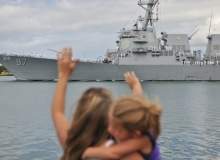

An armada of ships lines the piers at Naval Station Pearl Harbor, a sprawling military facility located just a few miles from the Hawaiian capital, Honolulu. The base is normally home to some of the US Navy’s biggest ships, but since 26 June it has also accommodated 49 ships from 22 different navies in readiness for RIMPAC.

Discover B2B Marketing That Performs
Combine business intelligence and editorial excellence to reach engaged professionals across 36 leading media platforms.
Held roughly every two years, RIMPAC is hosted and administered by the US Navy’s Pacific Fleet, which is based at Pearl Harbor. The exercise scenario involves four fictitious countries, with one playing the enemy force, in an island region. The drills take place around Hawaii and are split into a harbour phase and, after two weeks, an at-sea phase.
The US Navy invites countries from around the Pacific and beyond, to participate. It hopes RIMPAC can "foster and sustain the cooperative relationships that are critical to ensuring the safety of sea lanes and security on the world’s oceans".
Making headlines this year is the inclusion of China on the RIMPAC roster, the first time it has sent ships in the exercise’s 43-year history. Their participation may come as a surprise to some, especially as China is seen as a potential US adversary in the Pacific. China has sent four ships, including the destroyer Haikou and hospital ship Ark Peace.
Increased military cooperation between US and China

US Tariffs are shifting - will you react or anticipate?
Don’t let policy changes catch you off guard. Stay proactive with real-time data and expert analysis.
By GlobalDataRIMPAC 2014 will involve 23 nations, 48 surface vessels, six submarines, over 200 aircraft and 25,000 personnel.
China’s involvement in US-led naval drills forms part of wider effort to increase military cooperation between the two countries. During an April trip to Beijing, US Secretary of Defense Chuck Hagel met with Chinese defence officials and announced a "new model of military-to-military relations". The aim is to deepen practical cooperation in areas of common interest and manage competition.
India will also be participating in RIMPAC for the first time. It has sent the Shivalik-class frigate INS Sahyadri, an indigenously built ‘stealth’ vessel which entered into service in 2012. India’s participation reflects its growing defence relationship with the US.
In February it was revealed that India was the biggest importer of US-manufactured defence equipment, replacing Saudi Arabia. Although missing from the list of 200 aircraft which will be used during RIMPAC is the Indian Navy’s Boeing P-8I, a derivative of the US Navy’s P-8 Poseidon maritime aircraft.
Also absent are two countries which took part in the last RIMPAC exercise in 2012, Russia and Thailand. The US uninvited Thailand after the armed forces deposed the elected government in a coup d’état in May. And with tensions still high an invitation was not extended to Russia in response to the annexation of Crimea and ongoing instability in Ukraine. Russia has conducted large scale exercises with China this year but, according to experts, has been left isolated in Pacific military affairs.
The inclusion of Chinese and Indian ships in this year’s RIMPAC is a perfect opportunity to increase cooperation between the region’s navies. A four-week exercise is unlikely to alter the huge geopolitical shifts currently being experienced in the Asia-Pacific region, but greater training and understanding between navies could avoid future confrontations and accidental engagements in a region fraught with tensions.
Follow Grant Turnbull on Google+

.gif)


